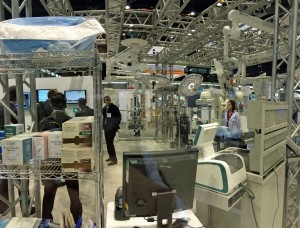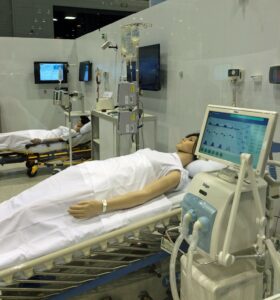![]() May 12, 2015 – Everything about HIMSS 2015 was huge. More than 1,100 vendors. Over 43,00 healthcare industry professionals teeming through three million square feet of exhibition space in Chicago. There were also big ideas about hot healthcare topics, from information and data management, analytics and patient engagement to population health, mobile healthcare, interoperability and security.
May 12, 2015 – Everything about HIMSS 2015 was huge. More than 1,100 vendors. Over 43,00 healthcare industry professionals teeming through three million square feet of exhibition space in Chicago. There were also big ideas about hot healthcare topics, from information and data management, analytics and patient engagement to population health, mobile healthcare, interoperability and security.

Complex problems can have simpler solutions
Big sometimes seems overwhelming, especially when it comes to managing patient and equipment data to mitigate risk and comply with HIPAA and Joint Commission mandates. Flashy booths and whiz-bang apps grab the eye and imagination. But organizations often overlook relatively simple, user friendly, cost effective solutions to secure ePHI and ensure equipment maintenance for compliance and security.
True interoperability remains elusive, and maintaining consolidated databases to track and monitor equipment requires the buy-in and cooperation of diverse stakeholders with often differing objectives and priorities. These dynamics can lead to prolonged and fragmented implementation, leaving lapses that endanger patients and cause costly fines from failed OCR audits.
The Swiftsure Group, a systems integrator specializing in RFID automated data capture and advanced asset management, takes a different approach. Protecting ePHI requires first locating, tracking and managing information about devices that capture, store or transmit sensitive data. Pumps, printers, tablets, phones. If organizations don’t know where devices are – stranded in a storage closet, discarded in a former employee’s office – they can’t possibly secure them or their data.

HIMSS demo – for dummies
To help organizations get a real handle on ePHI security and equipment management, Swiftsure has partnered with Verephi, whose team has helped healthcare organizations around the world track and manage physical assets since 2003.
Services include equipment audit and verification that are crucial to assessing risks to and safeguarding ePHI. Using automated data capture technology, Verephi also offers systems that enable healthcare providers to monitor and validate equipment sanitation and maintenance histories.
Here’s how it works. Instead of relying on centralized databases to track ePHI-containing equipment and maintenance records, the records themselves accompany each device on an attached RFID tag in an electronic format that can be easily retrieved. Each tag contains up-to-date usage and maintenance records such as time and type of cleaning, recalibration dates and scheduled maintenance.
For audits or identification of potentially contaminated equipment, a low cost handheld RFID reader retrieves data directly from the equipment. Fixed location readers at cleaning or equipment storage rooms identify equipments’ compliance with maintenance schedules to ensure that non-compliant equipment is not used. Alerts notify clinicians about milestones and missed deadlines.
While a number of HIMSS vendors touted RTLS systems for managing equipment, the cost and complexity of deployment – and unsolved issues with interoperability – make them unattractive compared to the passive off-the-shelf UHF solutions with automated, local equipment information storage solutions that Swiftsure recommends.
For more information contact Swiftsure or visit Verephi.
